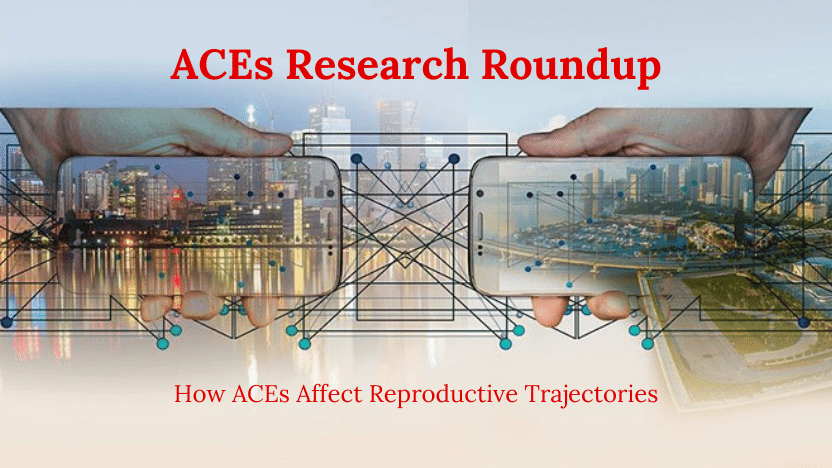Research Roundup: February 2021
Our monthly column highlights recent studies of Adverse Childhood Experiences (ACEs): causes, consequences, and the interventions that work.
Last month, our research roundup presented recent evidence about the intergenerational transmission of ACEs. This month, we focus on the period immediately preceding and following birth: how ACEs affect reproductive trajectories in women who are pregnant, as well as the potential role of social support in improving birth outcomes. We review two studies by Appleton, Holdsworth, and colleagues, using data from an ongoing prospective cohort study of pregnant women and their newborns. Exposure to early-life stress has been observed to result in earlier pubertal onset and early menarche (onset of menstruation), as well as younger age at first birth and low birth weight in offspring. While the biological mechanisms driving this relationship are not fully understood, some have suggested that early psychosocial stress disrupts the programming of the HPA axis, which may in turn impair HPA axis function during pregnancy and result in outcomes such as shorter gestation and lower offspring birth weight. , This hypothesis aligns with a framework of biological embedding, proposing that early-life adversity “gets under the skin” in irreversible ways (for a brief introduction to various life course models, please see our December research roundup here).Adverse Childhood Experiences are associated with early age at menarche and earlier gestational age among mothers who had experienced two or more ACEs.
Holdsworth and Appleton analyzed data from 214 soon-to-be mothers participating in the Albany Infant and Mother Study (AIMS). Because early menarche has previously been linked to adverse birth outcomes, the authors assessed 1) the relationship between ACE exposure and early menarche, and 2) early menarche and two birth outcomes (offspring cephalization, a measure of asymmetric fetal growth and vulnerability, and gestational age).Consistent with other studies of stress and pubertal onset, the authors found that experiencing a higher number of ACEs was associated with earlier menarche among mothers in the cohort. Further, early menarche only predicted offspring cephalization and gestational age among those who experienced two or more ACEs. These findings are important for several reasons. The relationship between offspring cephalization- the ratio of fetal growth later in gestation compared to earlier in gestation- has not been previously studied. The association between ACEs and offspring cephalization provides clues as tothe period during pregnancy that may be affected by maternal childhood adversity (late gestation), and reasons this might occur- for example, lower energetic capacity among mothers with a higher number of ACEs. The work also provides evidence for biological embedding hypotheses- that is, that exposure to ACEs may change biological programming, resulting in impacts decades after they occur. Finally, the relationship between early menarche and adverse birth outcomes was only present among mothers who experienced two or more ACEs. This indicates that early menarche may notconfer risk for negative birth outcomes independently, or for other genetic or environmental influences; it may confer risk only when it results from exposure to childhood adversity.Social support during pregnancy was protective against asymmetric fetal growth among mothers who experienced 3 or fewer ACEs, but not for mothers who experiences 4 or more ACEs.
Separately, Appleton and colleagues also examined social support as a potential intervention to promote better birth outcomes. Using data from same study (the Albany Infant and Mother Study, or AIMS), the authors examined whether social support impacted the relationship between maternal ACEs and offspring cephalization. As expected, the authors found that maternal adversity was associated with higher offspring cephalization scores, and social support was associated with lower cephalization scores. When examining the two in tandem, the authors found that social support lowered cephalization score for mothers with 3 or fewer ACEs, but did not have the same effect on those who experienced 4 or more ACEs. Effects were most pronounced for mothers who experienced no ACEs, but reductions in risk were still observed for those experienced 1-2 ACEs.These findings are important because they indicate that while ACEs are associated with poor birth outcomes, social support may mitigate risk and is an actionable, modifiable resource that can be provided to improve outcomes. For mothers with a history of 4 or more ACEs, more intensive interventions may be needed. The two studies reviewed here indicate that ACEs do have long-term negative, but that there are interventions that may be effective in mitigating or preventing them. Future studies should replicate these findings in larger populations and in other contexts. An especially promising direction of research will be uncovering the mechanisms through which these pathways of risk act, and in turn, can be acted upon.Works Cited
1Kalmakis, K. A., Meyer, J. S., Chiodo, L., & Leung, K. (2015). Adverse childhood experiences and chronic hypothalamic–pituitary–adrenal activity. Stress, 18(4), 446-450. 2Voellmin, A., Winzeler, K., Hug, E., Wilhelm, F. H., Schaefer, V., Gaab, J., … & Bader, K. (2015). Blunted endocrine and cardiovascular reactivity in young healthy women reporting a history of childhood adversity. Psychoneuroendocrinology, 51, 58-67. 3Holdsworth, E. A., & Appleton, A. A. (2020). Adverse childhood experiences and reproductive strategies in a contemporary US population. American Journal of Physical Anthropology, 171(1), 37-49.
Do you know your score?
Discover your ACE score and unlock a new understanding of your life. Take the test and gain insights into how your early experiences shape your well-being. Don't let your past define you – empower yourself with knowledge.

Gloria Hu
Doctoral Student, Epidemiology, Mailman School of Public Health
Gloria is an incoming doctoral student in epidemiology at the Mailman School of Public Health. Her recent research includes work with the Global Violence Against Children and Youth Surveys (VACS) and qualitative research involving HIV-positive, formerly incarcerated individuals and the reentry process. She has also previously volunteered at youth correctional facilities in upstate New York.
